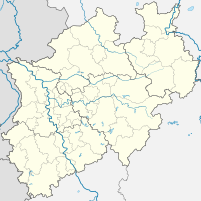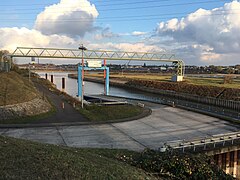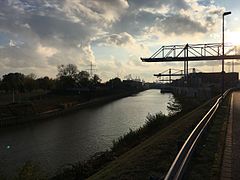Krupp port of Rheinhausen
| Krupp port of Rheinhausen | |||
|---|---|---|---|
| Data | |||
| UN / LOCODE | DE DUI | ||
| owner | City of Duisburg | ||
| operator | Logport Logistic-Center Duisburg GmbH | ||
| opening | 1897 | ||
| Port type | Inland port | ||
| website | logport I | ||
| Geographic information | |||
| place | Rheinhausen (Duisburg) | ||
| country | North Rhine-Westphalia | ||
| Country | Germany | ||
| Krupp Harbor in March 1976 | |||
| Coordinates | 51 ° 23 '51 " N , 6 ° 44' 16" E | ||
|
|||
The port of Rheinhausen is the former port of the Krupp iron and steel works in Duisburg-Rheinhausen . It is located on the Lower Rhine at river kilometer 773.6 on the left .
history
The construction of the Krupp iron and steel works in Duisburg-Rheinhausen began with a license application from the Krupp company for the construction of a port facility on June 29, 1865 at the Prussian Rhine River Administration in Koblenz . After initial concerns, it was issued by the Prussian Minister for Public Works on February 14, 1896 by decree .
The port expansion took place in several stages. In 1896/97 a 400 meter long port canal and a 375 meter long port basin were built in the area of the mayor's office in Friemersheim in what was then the municipality of Bliersheim . The system was extended by 156 meters in 1902/03, another 78 meters in 1912/13 and another 116 meters in 1925/26. The port was used exclusively for the transport of the iron and steel works.
In the mid-1950s, the length of the quay on the western side of the blast furnace was 765 meters, the eastern shipping quay was around 300 meters. The usable water surface was 80,000 m² with a bottom width of 60 meters. The storage area for ores (often shipped via the port of Rotterdam ) had a capacity of 0.75 million tons and 10,000 tons of coke could be stored.
Port operations
Incoming ships were maneuvered by the company's own port tugs and push boats to the loading facilities on the blast furnace side; they unloaded ore directly in front of the blast furnaces. For this purpose, five movable unloading bridges with a standing grab crane with a load capacity of 15 tons each and a fixed unloading bridge with a mobile grab crane with a load capacity of 10 tons were used.
Outgoing ships were loaded with rolling stock on the eastern bank, the shipping bank. In the 1950s, there was an ensemble of four mobile electric slewing cranes, each with a load capacity of 10 tons, on this quay .
At the end of the harbor basin there was also one from Fried. Krupp machine and steel Rheinhausen (later Krupp Industrietechnik GmbH) powered loading system consisting of a shipper Rick of 75 tonnes of load capacity as well as a tower crane with a lifting force is between 2 and 6 tons (depending on radius 30 to 15 meters).
envelope
The total throughput rose from 880,000 t in 1905/06 to 2,000,000 t in 1913/14 and to 2,481,000 t in 1927/28, reached a high of 3,714,000 t in 1938/39 and was in the mid-1950s at 2,435,000 t.
In the 1950s, the port's daily capacity was 10,000 tons. In 1978 the total throughput was 5,504 million tons. They were divided into 4.378 million tons of ore , 219,000 tons of steel and 766,000 tons of slag .
Factory shutdown, current use
When the factory closed in 1993, the port initially lost its function. Most recently, dismantled factory components were shipped via the port.
On the site of the former Krupp steelworks, a center for logistics companies has been built since 1998 with around 4,000 jobs under the name Logport I , which belongs to Duisburger Hafen AG . The port basin is now mainly approached by container ships, in particular by vehicle transports with new cars, which are parked on the former Krupp site and are shipped from here or transported by rail or truck.
In autumn 2002 the DIT Duisburg Intermodal Terminal was opened as the logistical centerpiece in Duisburg-Rheinhausen (120,000 m², investment sum 30 million €), which acts as an interface between the modes of transport ship, rail and truck and as a hinterland hub (distribution center) for the serves the major North Sea ports of Rotterdam and Antwerp.
Individual evidence
- ↑ all of the above data: Friedrich Albert Meyer: Rheinhausen am Niederrhein im historical becoming, 1956, p. 221 ff
- ↑ Arved Bolle, Rudolf Schwab: Yearbook of the port construction company , Volume 37, 1979/1980, p. 133 ff.
- ↑ Development of fallow industrial areas into modern logistics areas , Duisburger Hafen AG.





